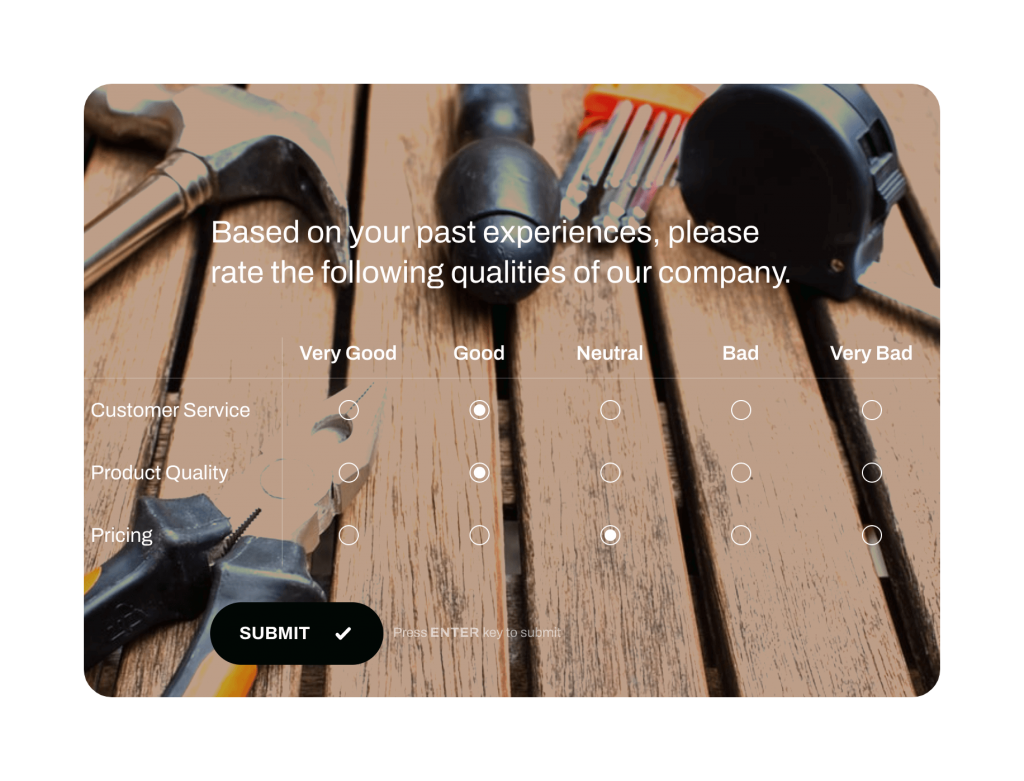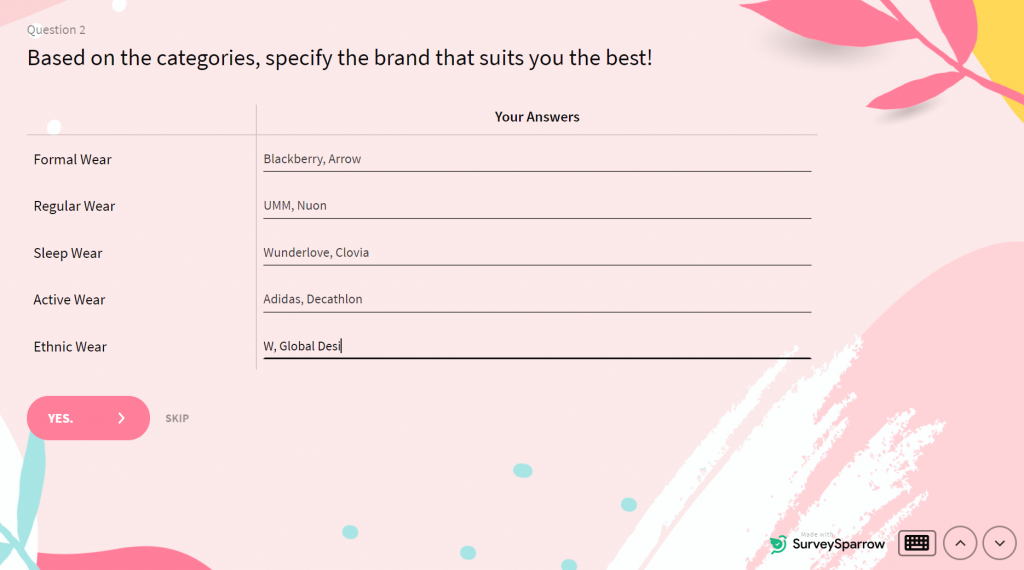Survey & Feedback
Matrix Survey Questions: Complete Guide with Examples & Best Practices
Article written by Kate Williams
Content Marketer at SurveySparrow
9 min read
19 September 2025

60-Second Summary:
Matrix questions are a powerful survey tool that bundle multiple related questions into a neat grid of rows and columns-think rating several aspects of customer service or product features all at once. This format saves time for both survey creators and respondents by consolidating similar queries into one easy-to-answer matrix.
Learn when to use matrix questions and why matrix questions is important.
Best practices include:
- Use concise wording
- Keep related items grouped
- Break large matrices into smaller chunks if needed
In short, matrix questions streamline feedback collection and deliver richer insights-perfect for surveys that need depth without overwhelming respondents.
Continue reading and happy surveying!
Are you wondering how to use matrix questions in your online surveys?
While most of us know about multiple-choice questions, text inputs, and dropdowns, we tend to miss out on an interesting question type – the matrix question.
In this blog, we discuss what are matrix questions, matrix surveys, and how to use a matrix question in your online surveys.
What Is a Matrix Question in a Survey?
A matrix question is a collection of multiple-choice questions rolled into one. Like the Likert Scale, the matrix question type is a rating scale arranged in a grid of rows and columns. While the rows have the questions, the columns have the answer options for each question in a row.
In a typical matrix question:
Rows contain the items being evaluated
Columns contain the response options or rating scales
Each cell in the grid represents the intersection of an item and a response option
This efficient format allows respondents to quickly rate multiple items without having to read repeated question prompts or scale definitions.
Here’s a matrix question example.

In this example, the rows contain different aspects of customer satisfaction (customer service, product quality, etc.), while the columns present a satisfaction scale from “Very Bad” to “Very Good.”
Matrix questions differ from standard multiple-choice questions in that they allow for evaluating multiple related items simultaneously using the same scale or criteria, creating a more efficient survey experience for both creators and respondents.
When to Use Matrix Survey Questions
You can use a matrix question to rate a group of similar attributes or similar topics clubbed under one query. Due to this feature, matrix questions are great for:
- Customer experience/satisfaction surveys
- Employee experience/satisfaction surveys
- Performance assessment surveys
- Product testing and feature rating
For example, you want to take post-event feedback from your audience. Apart from the usual questions, like “How smooth was the registration?” and “Where did you hear about us?” your audience can rate their experience on specific parameters.
Matrix questions have a variety of applications – as a single question type within a survey form, as a subtopic in a more extensive questionnaire, as a mini-survey on its own, or as an offline form. Its closed-ended, predefined answer options also enable you to segment the data and view the results by attributes. Let’s take you through an example.
Mia, a regional bank manager, wants to segment the state, city, and branch data. Through survey software, she can get the branch location from the survey using custom variables and IP tracking. Then, Mia can create a cross-tabulation report with the data segmented by branch, city, and state. She then analyzes the data to discover underperforming units and uses this knowledge to create improvement plans.

6 Types of Matrix Questions for Surveys
There are 6 primary matrix question types. Here’s a matrix survey created using SurveySparrow…
Sign up for FREE to create a similar matrix question survey.
14-day free trial • Cancel Anytime • No Credit Card Required • No Strings Attached
Types of matrix survey questions are:
Single-Select Matrix Questions
This lets you choose just one answer from each row. This is used when a multiple-choice question covers several related topics.
Best for: Scenarios where each item being evaluated has only one appropriate response or rating.
Example: When a hotel asks their guests to rate them on the factors that make up their experience, like rooms, pool, spa, etc.
Radio Button Matrix Questions
So-called because they look like the push buttons of old radios. Radio buttons allow you to select only one answer option from each row. When you select one button, it deselects the rest.
Best for: Making it visually clear that only one option can be selected per row.
Example: An event feedback form asking participants to rate different aspects like venue, content, speakers, and networking opportunities on a satisfaction scale.
Multi-Select Matrix Questions
You can choose multiple answers from each row. This type is helpful for most kinds of surveys, especially marketing.
Best for: Scenarios where multiple valid options might apply to each item being evaluated.
Example: When you want to know all the features that your audience likes about your competitors.
Checkbox Matrix Questions
Self-explanatory. Checkboxes are multi-select. Clicking one checkbox doesn’t uncheck the others.
Best for: Clearly communicating to respondents that they can select multiple options per row.
Example: A survey asking which communication channels (email, phone, text, social media) customers prefer for different types of communication (promotions, support, billing, etc.).
Dropdown Matrix Questions
Dropdown matrix questions replace the standard column options with dropdown menus in each cell of the matrix.
Best for: Matrices with many potential response options that would make a traditional matrix too wide, or when comparing items across different time periods.
Example: A workplace assessment comparing various aspects of working conditions (salary, equipment, training, safety) over the past two years, with dropdowns containing response options for “Year 1” and “Year 2.”
Text Input Matrix Questions
Text Input matrix questions combines the advantages of open-ended questions, multiple-choice, and the matrix into one neat little package.
Best for: Collecting specific comments or quantitative information about multiple related items.
Example: A product development survey asking respondents to provide price estimates for different potential features of a new product.
You can also use the text input matrix question like this…

Advantages of Matrix Questions in Surveys
Matrix survey questions offer several significant benefits that make them valuable tools in survey design:
- A matrix question consolidates various rating-scale questions in an easy-to-digest format. So instead of asking 2-3 questions, you can club them in a single query.
- This trait saves a lot of time for the survey creator and respondent.
- Matrix questions also save the respondent from the monotony of answering similar questions back-to-back, ensuring a higher response rate.
Pitfalls of a matrix question
- Matrix questions work best with five items or less.
- For optimum viewability, the matrix should not have more than 3-5 columns. Any more can create clutter and impact viewability.
- If your matrix doesn’t abide by these rules, it is not smartphone-compatible. In general, the matrix layout makes it unsuitable for many mobile devices. It requires a lot of pinching, zooming, and scrolling on a small screen.
- Due to their layout, matrix questions are incompatible with chat surveys and pop-up surveys.
If your web-recruited studies are seeing markedly less than 40% mobile participation, your study is probably not obtaining a representative sample due to it being too long or complex.
Hilary DeCamp
Best practices for matrix questions
- Avoid too many words, and keep the item text and response options short. For example, if the text spills over onto the following line, it’s too long.
- If you can’t fit all of the points on one screen, or you have to scroll to get to the bottom of the list, consider breaking it up into smaller matrixes or multiple-choice questions.
- Test how it looks and responds on mobile. You don’t want to miss out on data because the matrix “broke” on a smartphone.
- Make sure the items come under the same topic. For example, the question is about the shopping experience. In that case, the items should be related to the shopping experience – like the ease of discovery, service, checkout, cleanliness, etc.
Wrapping up
Remember that matrix questions are just one tool in your survey design toolkit. They excel in specific scenarios but aren’t appropriate for every situation. Always consider your research objectives, target audience, and survey context when deciding whether to use matrix survey questions.
For those ready to create engaging surveys with effective matrix questions, SurveySparrow offers intuitive survey building tools with mobile-optimized matrices and powerful analytics.
There you have it. If you’re looking for more tips on how to use even more engaging question formats, we’ve got you covered. You can also give them a try yourself by signing up for a free account. Happy surveying!
14-day free trial • Cancel Anytime • No Credit Card Required • No Strings Attached

Create engaging surveys that people actually complete. Try SurveySparrow now!
Kate Williams
Frequently Asked Questions (FAQs)
A Likert scale is a specific type of matrix question that measures agreement or disagreement with statements. While all Likert scales can be presented as matrix questions, not all matrix questions are Likert scales. Matrix questions can use various response scales beyond agreement, such as satisfaction, importance, frequency, or quality ratings.
Matrices with more than 7 items show significant increases in “straight-lining” behavior, where respondents select the same answer for all items without careful consideration. If you have more than 5 related items to evaluate, consider breaking them into multiple smaller matrices grouped by subtopic.
Matrix questions can be challenging on mobile devices due to their grid format requiring more screen space. However, they can work well on mobile with proper optimization. Best practices include: limiting the number of columns and rows, using abbreviated scale labels on mobile, ensuring text doesn’t wrap, and testing on multiple device sizes before launch
While technically possible in some survey platforms, using different response scales within the same matrix is not recommended as it creates confusion and increases cognitive burden for respondents. The primary advantage of matrix questions is that respondents can quickly evaluate multiple items using the same criteria.
Related Articles

Survey & Feedback
Pollfish vs SurveyMonkey vs Qualtrics: A Comparison
12 MINUTES
7 March 2024

Survey & Feedback
60 Must-Ask Student Survey Questions With Examples
16 MINUTES
23 January 2024

Survey & Feedback
How to Create a Survey Spreadsheet Template: A Step-by-Step Guide for Beginners
12 MINUTES
10 May 2025

Survey & Feedback
How to Make Google Forms Anonymous: A Comprehensive Guide
8 MINUTES
10 March 2024
